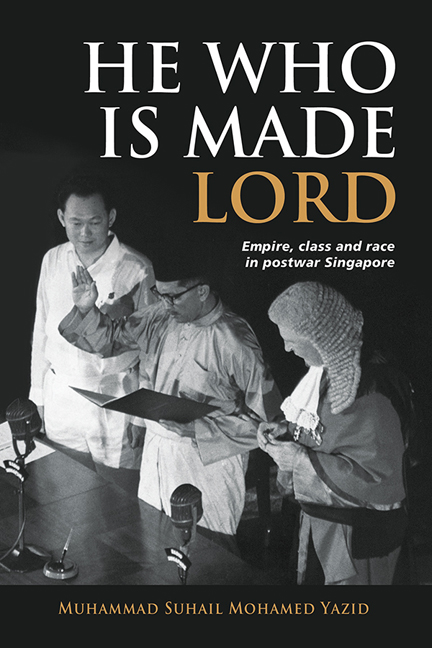Book contents
1 - Yang di-Pertuan Negara of Singapore
Published online by Cambridge University Press: 01 March 2024
Summary
On the morning of 3 December 1959, Yusof bin Ishak, smartly dressed in a beige Baju Melayu, arrived at the centre of Singapore town in a Rolls-Royce. Prime Minister Lee Kuan Yew greeted Yusof and ushered him into a chamber at the heart of the City Hall building. Dozens of politicians, officials and foreign dignitaries were already waiting for Yusof. Following his entry, the magisterial melody of God Save the Queen reverberated off the chamber's walls, followed by the confident tune of the new state anthem, Majulah Singapura.
All present were standing. Ahmad Ibrahim, the advocate-general, then read out the Commission of Appointment from Queen Elizabeth II, recognizing Yusof as Her Majesty's representative in Singapore. Yusof recited his oath of allegiance in Malay:
I, Yusof Bin Ishak, do swear that I will well and truly serve Her Majesty Queen Elizabeth II, her heirs and successors, in the office of Yang di-Pertuan Negara. So, help me God.
Prime Minister Lee and the chief justice, Sir Alan Rose, witnessed the oath. After the signing of all official documents, both anthems echoed once more, but this time, Majulah Singapura took precedence. Yusof was now Singapore's first Malayan-born Yang di-Pertuan Negara
(“he who is made lord”). Even though he represented the sovereign power of the British monarch on the island state, the Queen's portraits were nowhere to be seen in the chamber.
After the solemn procedures, the newly appointed Yang di-Pertuan Negara and his entourage emerged from City Hall to much fanfare. Fleets of buses and lorries had ferried schoolchildren and youths to the grand ceremony. In spite of the light drizzle, the 10,000-strong exuberant crowd greeted the Yang di-Pertuan Negara with shouts of “merdeka”, which was by now a familiar rallying cry meaning “freedom” or “independence” in Malay. City Hall's grandiose structure and its colossal Corinthian columns towered over the crowd and had for many decades projected the might of British imperium. During official events, Singapore's colonial rulers often stood at the very top of the perron, lifting their visual presence over crowds assembled at the grassy forecourt of the Padang. This spatial arrangement projected the hierarchical realities of the relationship between rulers and subjects. The Padang itself has a deeper history. As a “colonial civic space”, it was the site of commemorative events to display the might of the reigning imperial power, whether it was the British or the Japanese.
- Type
- Chapter
- Information
- He Who Is Made LordEmpire, Class and Race in Postwar Singapore, pp. 1 - 37Publisher: ISEAS–Yusof Ishak InstitutePrint publication year: 2023

